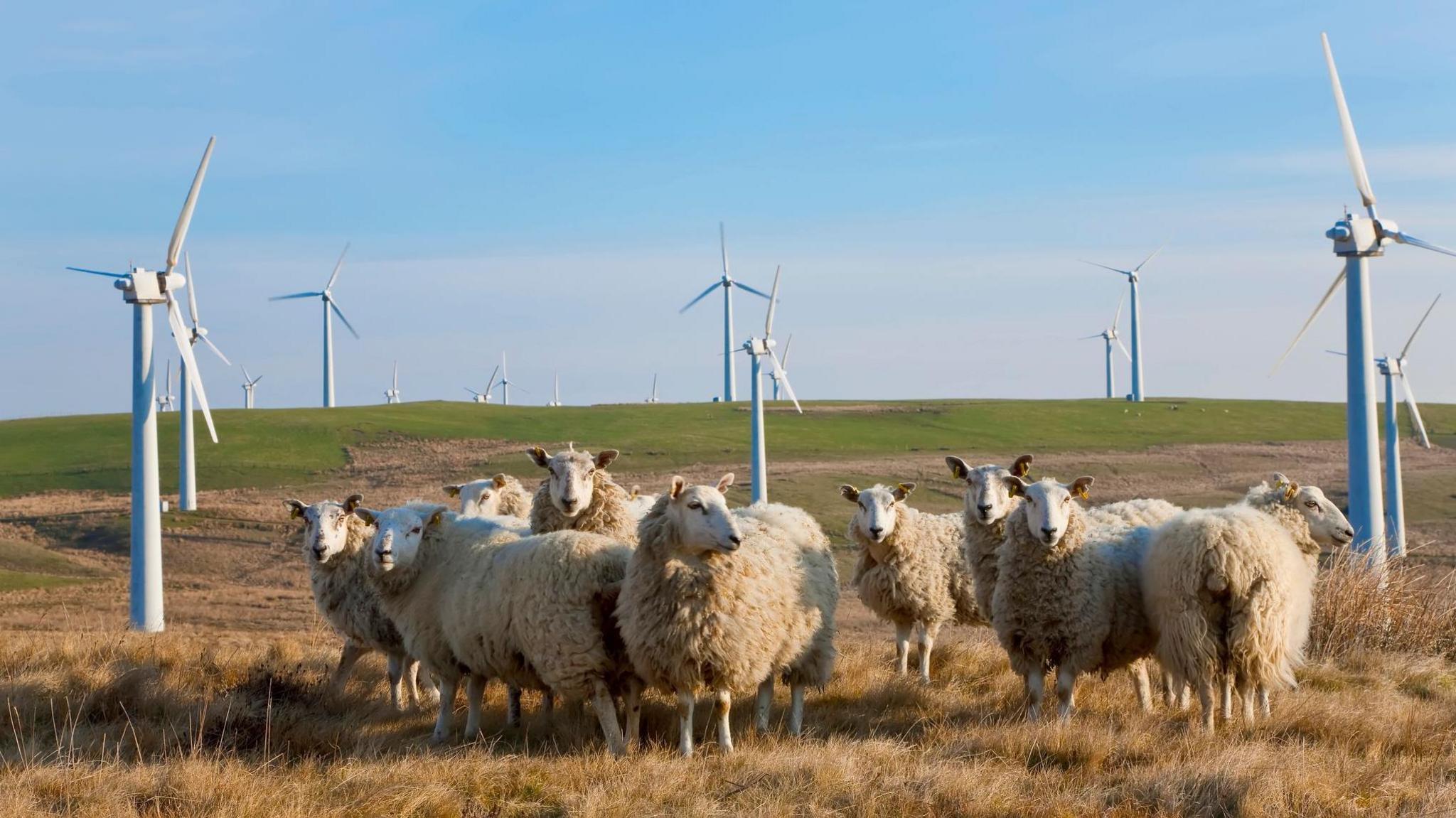Ukraine 'built more wind farms than Wales' amid war

Welsh ministers are said to have placed green jobs and growth at the very top of their agenda
- Published
Ukraine has managed to build more onshore wind capacity than Wales despite being invaded by Russia, an industry body has said.
RenewableUK Cymru said Wales risks falling behind the rest of the UK in the race to meet clean power targets, having built just four mini turbines since January 2023.
It said a lack of electricity grid capacity made it hard for projects to get off the ground, while there were severe delays in the decision-making process.
The Welsh government said First Minister Eluned Morgan "has placed green jobs and growth at the very top of the agenda".
Four times more wind power needed to hit net zero
- Published7 November 2023
Claim wind and solar may industrialise rural Wales
- Published12 August 2023
Green energy plan 'won't benefit' Welsh valley residents
- Published18 June 2024
Ukraine's Tyligulska wind power plant, which was built during the ongoing conflict with Russia, has started generating clean energy to power about 200,000 homes according to DTEK, an investor in Ukraine's energy industry.
The plant, which is based just 60 miles (96.5km) from the frontline in the southern region of Mykolaiv, has 19 turbines providing an installed capacity of 114MW.
Since the start of 2023, Wales has provided a capacity of 3.2MW through four mini turbines.
In England, 8.3MW has been created since a 2015 ban on onshore wind was lifted in July.
RenewableUK Cymru said it wants "urgent action" to speed things up, after decisions on three wind farms – capable of powering 170,000 households annually - were delayed.
It wants a "four nations renewables team" to ensure Wales does not miss out on opportunities from the UK government’s GB Energy initiative, external.
It said one wind farm at Garn Fach, Powys, has been awaiting approval for more than two years.
The UK government wants to double onshore wind, triple solar power and quadruple offshore wind by 2030, and for all electricity to come from zero-carbon generation by 2035.
Most decisions on large projects in Wales rest with the Welsh government.
RenewableUK Cymru director Jess Hooper said: "Without timely action there is a real risk that Wales will miss this investment opportunity and fall behind in the UK’s race to meet the 2030 clean power target."
The Welsh government said it would support a collaborative approach across the UK for "renewable energy opportunities".
However, it added that green jobs and growth were at the very top of the agenda with energy, economy and planning all in the same department to make sure projects are considered as a matter of urgency.

Sarah Pye fears much of Anglesey landscape could become "black fields"
But not everyone is keen on more wind and solar farms.
From her home in Rhosgoch, Anglesey, mother-of-two Sarah Pye, 36, can already see the Wylfa nuclear power station, large wind turbines and fields of solar panels.
As well as a solar development, there are two solar farms being proposed, including Lightsource BP's Maen Hir proposal which would be the size of 1,700 football pitches.
The 350MW development would power more than 130,000 homes, and be almost five times bigger than the UK’s current largest active solar farm.
"Honestly, it breaks my heart, breaks my soul," Sarah said.
She compared it to the flooding of the village of Capel Celyn in the 1960s to create a reservoir.
"I think it’s round two of 'Cofiwch Dryweryn' [a campaign slogan against this], and people being forced out of their homes," she said.
"But this is actually on a larger scale."
Lightsource BP said there would be no compulsory purchase of residential buildings and "no-one will be required to leave their homes".
It added that the company is "committed to developing a project that co-exists with ongoing farming activities, as well as boosting local biodiversity", and urged people to engage with a statutory consultation which is under way.

Apprentices Grace and Hollie see their future in wind turbines, but want a faster rollout
The UK’s largest power generator, RWE, runs an apprenticeship programme for wind turbine technicians in Rhyl, Denbighshire.
Grace Dennehy, 17, is confident there will be enough job opportunities, but said decisions on developments should move faster.
Hollie Massey, 17, added: "There’s always going to be a future in renewables so I know I’m not going to run out of choices."
Key to meeting renewables targets will be the UK government’s flagship GB Energy.
In opposition, UK Labour claimed its Green Prosperity Plan, external would "lead to more than 29,000 jobs in Wales" and GB Energy would build more than 1,000 local power projects.
But many in the industry still do not know exactly what GB Energy means for Wales.
Marine Energy Wales agrees the country “runs the risk of getting left behind without change when it comes to floating offshore wind (FLOW)", and it hopes GB Energy will "accelerate the industry".
The Campaign for the Protection of Rural Wales, believes onshore wind is "dreadful" for the countryside, and wants GB Energy to focus on "offshore wind in both the Celtic and Irish Seas".
Welsh Secretary Jo Stevens said Wales would "play a huge role in what GB Energy is going to do", and said a new partnership between the company and the Crown Estate would pave the way to attracting private investment to establish floating offshore wind.
The Welsh government added that it has consented to renewable energy projects this year, with the generating capacity equivalent to the needs of about 133,000 homes annually.
It also said 22 other projects were being considered.